(This is the fifth article in our new Agri-Pulse series, “The Seven Things You Should Know Before You Write the Next Farm Bill.” Each segment provides important background and “lessons learned” that can help inform and stimulate debate before formal work starts on writing the next farm bill.)
WASHINGTON, March 12, 2017 - It’s a time-honored tradition for any legislative advocate to look for partners who can align politically.
Over the history of U.S. farm bills – dating back to the 1930s – the “traditional” farm organizations have aligned with a wide variety of other special interest organizations, ranging from labor unions to nutrition advocates and conservation groups.
 But as attacks from groups on both the ultra-left and ultra-right escalated during the 2014 farm bill debate, one thing was becoming crystal clear for farm organization leaders: They needed more “friends” in order to hold on to crop insurance, conservation and even some of their desired commodity programs.
But as attacks from groups on both the ultra-left and ultra-right escalated during the 2014 farm bill debate, one thing was becoming crystal clear for farm organization leaders: They needed more “friends” in order to hold on to crop insurance, conservation and even some of their desired commodity programs.
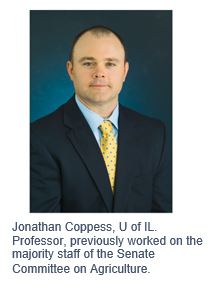 And not just any friends. Farmers and ranchers needed passionate advocates who could fill out the congressional “map” a lot better than they could.
And not just any friends. Farmers and ranchers needed passionate advocates who could fill out the congressional “map” a lot better than they could.
Agriculture and food production exists in every state and therefore, has strong representation in the U.S. Senate. But in the House of Representatives, the corn, cotton and wheat coalition that has historically played a leading role in shaping farm policy and passing farm bills no longer fills out much of the congressional maps.
Jonathan Coppess and Todd Kuethe, writing for farmdoc daily last year, used data on major crop growing areas from USDA’s National Agricultural Statistics Service to illustrate how some of the traditional farm coalition “previously gained and currently maintains national support for commodity programs by uniting producers across regions.” (See map below.)
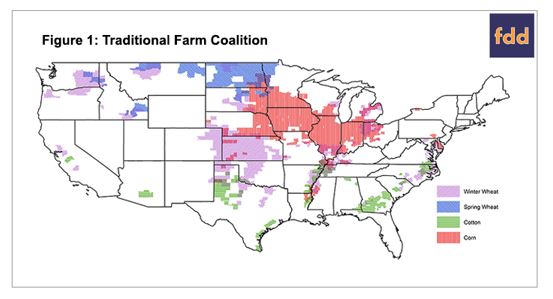
Then Coppess and Kuethe identified the largest possible political footprint for corn, cotton and wheat by every congressional district that contains at least some portion of a major crop producing county (based on the 114th Congress).
For example, the 533 counties classified by USDA as major corn producers intersect 82 congressional districts. Similarly, the 148 major cotton-producing counties intersect with 38 congressional districts; winter and spring wheat are big in 411 and 84 counties that intersect 91 and seven congressional districts, respectively. (See corn map, below.) “It is important to reiterate that our definition identifies the largest possible political footprint of each commodity,” they noted.
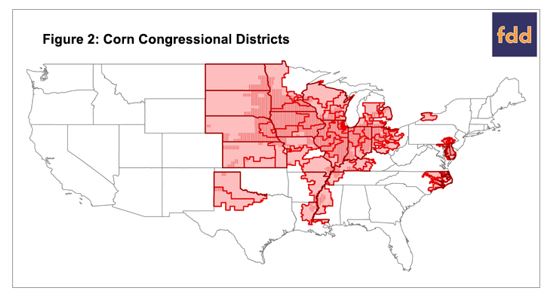
These maps may not demonstrate how much actual political influence growers have in a farm bill debate, the authors noted.
“For example, several districts in the Mississippi Delta, Northern Texas, and Eastern North Carolina are identified as major production areas for corn, cotton, and wheat. It is unlikely that all three commodities will have the same political impact in these areas,” they wrote.
Others have tried to analyze the political influence of farmers by looking at “farming dependent” counties,” as mapped by USDA. In a 1985 Economic Research Report on “Agricultural Policy, Rural Counties and Political Geography,” authors Bernal Green and Tom Carlin identified 702 counties with 20 percent or more of labor and proprietor income from production related to farming and ranching from 1975-1979

In its most recent 2015 report, ERS found 444 farming dependent counties out of the 3,144 in the U.S. These were defined as the counties where 25 percent or more of the county’s average annual labor and proprietors earning were derived from farming, or 16 percent or more of jobs were in farming. (See map below).

Going into the last farm bill debate, some farm organization leaders didn’t need maps to do the basic “math” about their declining numbers.
 “You don’t have to tell too many people that farmers are less than 1 percent of the U.S. population. And the other 99 percent of the population has their own ideas and voices, too,” noted former National Corn Growers Association President Pam Johnson.
“You don’t have to tell too many people that farmers are less than 1 percent of the U.S. population. And the other 99 percent of the population has their own ideas and voices, too,” noted former National Corn Growers Association President Pam Johnson.
Still, some farm organization leaders were initially reluctant to reach out to other interest groups as the debate started to heat up on the last farm bill in early 2011. Whom could they trust? Who would be with them throughout the long slog that would become the 2014 farm bill?
“Early on, there was so much apathy about the last farm bill because commodity prices were relatively high,” recalled a farm organization leader who asked not to be identified. “And they were reluctant to push back against Tea Party Republicans who wanted to reform food stamps and split the bill.”
Historic coalitions frayed
Historically, farm groups have partnered with nutrition groups to advance both the “farm” and the “food and nutrition” portions of the farm bill – building on a partnership launched in the early 1970s when Sens. Bob Dole, R-Kan., and George McGovern, D-S.D., formed a coalition that was mutually beneficial to both urban and rural constituencies.
But that coalition had frayed as the farm bill debate was really heating up in 2012 – in part because many lawmakers were singularly focused on reducing the massive federal debt.
For conservative groups like the Heritage Foundation, Taxpayers for Common Sense and the Competitive Enterprise Institute (CEI), the farm bill became a “poster child” for what they viewed as wasteful federal spending. These groups understood that agriculture committee leaders were likely to make big reforms by getting rid of so-called “direct” payments to farmers. But they believed that since the bill was still projected to cost nearly $1 trillion, more reforms were needed.
Meanwhile, on Capitol Hill several lobbyists were already focused on building coalitions that could broaden their geographic and political bases and push back attacks that were coming from not only the ultra-right conservative groups but from ultra-left organizations like the Environmental Working Group.
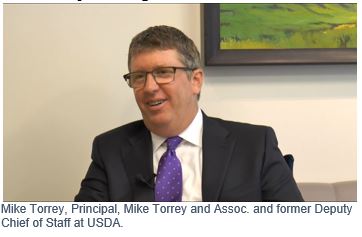 Some of these same folks had watched in alarm as the Humane Society of the U.S. (HSUS) had partnered with the United Egg Producers in 2011 to press Congress for new national standards for the welfare and housing of millions of hens.
Some of these same folks had watched in alarm as the Humane Society of the U.S. (HSUS) had partnered with the United Egg Producers in 2011 to press Congress for new national standards for the welfare and housing of millions of hens.
“There is an HSUS chapter or affiliate in every major urban and suburban area in America,” noted a former Senate staff member. “The number of people they can reach out to and stir up to deliver messages on Capitol Hill is probably bigger than all of the farm groups put together.”
So broadening coalitions to help secure votes and move a farm bill forward was a crucial part of the Senate and House farm bill strategies.
“The rules of the game have changed,” added Mike Torrey, principal and founder of Michael Torrey Associates. “Today, effective lobbying takes building alliances across industries and party affiliations. A single voice is not often heard, but a diverse coalition can elevate an issue and deliver real results. It’s not easy, but it is effective."
Connecting farmers with ‘hook’ and ‘bullet’ groups
One of the most successful coalitions in the last farm bill involved not only traditional farm organizations but those representing a vast array of conservation, hunting, fishing and wildlife groups.
In some respects, it was not a totally new relationship. Conservation was at the core of the very first farm bill as farmers and environmentalists worked to contain the “Dust Bowl” where dry winds were sweeping across the plains and blowing away valuable top soil in the early 1930s.
Later, in the Agricultural Act of 1956, Congress established the “Soil Bank Program” to retire sensitive lands while reducing surplus production.
But modern-day conservation policy was primarily “birthed” in the early 1980s. The 1981 farm bill was the first to contain a conservation title with nearly a dozen initiatives – but most were never funded.
For the 1985 farm bill, Indiana Sen. Richard Lugar, pushed for enactment of the Conservation Reserve Program, aimed at idling highly erodible lands and taking millions of acres out of production in an effort to boost commodity prices.
Then-Secretary of Agriculture John Block also wanted to push ahead with creation of the CRP – much to the dismay of President Ronald Reagan’s budget director, David Stockman.
“Stockman didn’t like farm programs and he especially didn’t like the CRP,” recalled a former USDA official who worked for Block at that time. But sportsmen were ecstatic about the possibility of more idled land for pheasants and other wildlife to nest in and increase populations. Early support included the Wildlife Management Institute and the International Association of Fish and Wildlife Agencies.
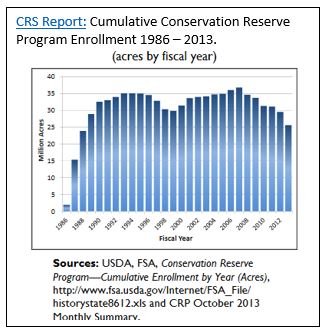 The 1985 farm bill also included conservation compliance requirements: To be eligible for commodity payments and crop insurance premium discounts, farmers had to comply with “swampbuster” provisions (designed to discourage cropping of wetland areas), and “sodbuster” provision (designed to discourage tilling grasslands and native prairie) and were given 10 years to develop conservation planning for any farming on Highly Erodible Land (HEL).The CRP was launched in the 1985 farm bill, and by 1986, five million acres were enrolled in the program which retired land under long-term (10-15 years) contracts. Enrollment rose to an all-time high of 36.7 million acres by 2007.
The 1985 farm bill also included conservation compliance requirements: To be eligible for commodity payments and crop insurance premium discounts, farmers had to comply with “swampbuster” provisions (designed to discourage cropping of wetland areas), and “sodbuster” provision (designed to discourage tilling grasslands and native prairie) and were given 10 years to develop conservation planning for any farming on Highly Erodible Land (HEL).The CRP was launched in the 1985 farm bill, and by 1986, five million acres were enrolled in the program which retired land under long-term (10-15 years) contracts. Enrollment rose to an all-time high of 36.7 million acres by 2007.
But by the 1996 farm bill, dubbed “Freedom to Farm,” concerns were growing that farm policy needed to be more market-oriented. Political and budget pressure focused lawmakers on reducing farm program payments – moving away from historical systems based on target prices and payments delivered when prices fell below those target levels – to a new system based on what were supposed to be gradually declining direct payments. These direct payments were paid regardless of planting or price.
As he was moving to a new form of farm program payments, Kansas Republican Pat Roberts, then the House Agriculture Committee chairman, also hoped to offer producers more regulatory relief. He was able to deliver on many fronts, but one was especially well-received by both producers and the crop insurance industry: the Federal Agriculture Improvement and Reform (FAIR) Act of 1996, which removed the link between crop insurance premium subsidies and conservation compliance requirements.
Fast forward to 2014
As members of Congress started shaping a new farm bill in 2011, it became clear that direct payments to farmers – which were paid regardless of whether or not a crop was planted – were no longer politically sustainable.
So what could farm bill critics attack next? After the failure of the “Super Committee” in 2011, the Environmental Working Group (EWG), started to focus on crop insurance. The group –which has long published growers’ farm program payments – tried, unsuccessfully, to obtain information on every growers’ crop insurance subsidy so they could also publish the information. One of the group’s goals was to limit premium subsidies and trim participation in crop insurance by capping the adjusted gross income (AGI) level for the nation’s largest growers. They also pushed to relink crop insurance to cross-compliance provisions.
Just one day before the Senate Agriculture Committee held a hearing on farm bill conservation issues in February 2012, EWG released a new paper to make the case for linking crop insurance benefits to conservation cross-compliance and updating farmers’ conservation plans.
 EWG was not alone. Senate Agriculture Committee leaders knew that attacks on crop insurance could come from several different sources, including conservative groups who wanted to dismantle the farm bill and nutrition advocates who were upset about cuts that were made in the SNAP program. (For a list of amendments offered to what became the 2014 farm bill, see below.) “Insurance programs have quietly turned into the most expensive and farm-reaching subsidy today,” Craig Cox, EWG’s senior vice president for agriculture and natural resources, told Agri-Pulse. At the same time, “we are concerned that the conservation compact is eroding.”
EWG was not alone. Senate Agriculture Committee leaders knew that attacks on crop insurance could come from several different sources, including conservative groups who wanted to dismantle the farm bill and nutrition advocates who were upset about cuts that were made in the SNAP program. (For a list of amendments offered to what became the 2014 farm bill, see below.) “Insurance programs have quietly turned into the most expensive and farm-reaching subsidy today,” Craig Cox, EWG’s senior vice president for agriculture and natural resources, told Agri-Pulse. At the same time, “we are concerned that the conservation compact is eroding.”
During the Senate farm bill debate in 2012, Sen. Saxby Chambliss, R-Ga., offered an amendment to re-establish the link between conservation compliance and crop insurance. It was widely viewed as a way to push back against Pat Roberts, now a senator, for voting against Southern interests on their desired commodity policies. The amendment narrowly passed the Senate by a vote of 52 in favor and 47 opposed.
In the Senate, there was already strong support for “means testing” on crop insurance subsidies. Sens. Dick Durbin, D-Ill., and Tom Coburn, R-Okla., partnered on an amendment that would reduce premium support on crop insurance by 15 percent for farmers with an Adjusted Gross Income (AGI) over $750,000. It passed as an amendment during the first Senate farm bill vote in June 2012 by a large margin, 66-33.
If this amendment was included in the final farm bill, farm organizations feared that many of their members would be forced out of crop insurance, making the rates much costlier for the remaining farmers and ultimately, making the program unsustainable.
Ducks to the rescue?
It didn’t take long for American Farm Bureau Federation’s Senior Director of Congressional Relations Mary Kay Thatcher and former Natural Resources Conservation Chief Bruce Knight – now a principal at Strategic Conservation Solutions – to launch a series of conversations with Dan Wrinn, the director of public policy for Ducks Unlimited (DU).
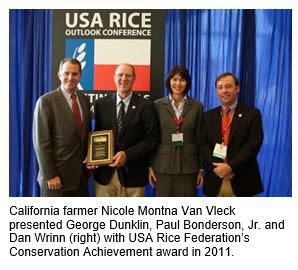 To address their goal, DU wanted farm organizations to support re-linking conservation compliance requirements to crop insurance. But that “ask” made some farmer leaders extremely nervous. They had a mutual goal: maximizing the amount of conservation taking place on U.S. farmland. Wrinn recognized that market forces were working against conservation efforts on the prairies and in other high-priority waterfowl areas. High commodity prices were encouraging many farmers to put their expiring CRP land back into row crop production.
To address their goal, DU wanted farm organizations to support re-linking conservation compliance requirements to crop insurance. But that “ask” made some farmer leaders extremely nervous. They had a mutual goal: maximizing the amount of conservation taking place on U.S. farmland. Wrinn recognized that market forces were working against conservation efforts on the prairies and in other high-priority waterfowl areas. High commodity prices were encouraging many farmers to put their expiring CRP land back into row crop production.
“We agreed to fight AGI if others would support conservation compliance with crop insurance,” noted Wrinn, who said that this was a change in perspective for his organization.
After realizing that direct payments and ties to conservation compliance would likely be gone in a new farm bill, DU recognized that helping both large and small farmers would be key to their own mission of filling the skies with ducks and geese for future generations. Crop insurance became the next logical connection to keeping conservation on the land.
But it wasn’t an easy coalition to form and keep together.
“It wasn’t really until Senate Agriculture Committee Chairwoman Debbie Stabenow (D-Mich.) asked the groups to get moving that it all came together,” recalls Knight.
As the coalition gained traction, it also attracted criticism from some traditional and important voices. Then-House Agriculture Committee Chairman Frank Lucas, R-Okla., opposed linking conservation compliance with crop insurance, and his staff made it very clear that he did not approve of farm organizations lending their names to this effort. That push provided extra incentives for some farm organization leaders – who weren’t sure they wanted to partner with the so-called “hook and bullet” groups to begin with – to stay away entirely.
Over time, even the American Farm Bureau Federation pulled their support – citing the need to strictly follow its own policy book.
For his part, Wrinn had to deliver the bad news to a long-time ally – Sen. Durbin – explaining that his organization would not be supporting the senator’s AGI amendment.
“Never would I have thought that I would be setting up Capitol Hill visits for corn and soybean farmers,” Wrinn told attendees at a crop insurance industry convention the following year. He described the coalition as “innovative and out of the ordinary.”
Other farm and conservation organizations joined the coalition in support of linking conservation compliance to crop insurance and opposing the AGI amendment. They included the National Corn Growers Association, the American Soybean Association, the National Cotton Council and the National Association of Conservation Districts, Audubon, Environmental Defense Fund, Pheasants Forever, the Theodore Roosevelt Conservation Partnership and the National Wildlife Federation.
Almost one year later, the Senate once again approved Durbin and Coburn’s AGI amendment to the farm bill, but with slightly fewer votes. It passed by 59-33.
In the House, however, the coalition celebrated a victory when Wisconsin Rep. Ron Kind’s amendment to “means test” crop insurance was narrowly defeated, 208-217.
“The success of the conservation compliance coalition was just one tiny example of what’s possible when you move out of your comfort zone,” noted David Graves, who lobbies on behalf of the crop insurance industry and persuaded his members to stay engaged in the coalition. “We just need to keep learning and building coalitions.”
Specialty crops expand the map
Commodity and the crop insurance industry leaders also worked to expand their reach (and their influence map) by working with the Specialty Crop Farm Bill Alliance – a national coalition of more than 120 organizations. U.S. farmers grow more than 350 types of fruit, vegetable, tree nut, flower, nursery and other horticultural crops – primarily in parts of the country that have not historically been involved with the farm bill, pointed out the Congressional Research Service in a report on specialty crop issues in the 2014 farm bill.

CRS noted that many programs supporting specialty crops were established in the “Specialty Crops Competitiveness Act of 2004” (a non-farm bill year) and further expanded and reauthorized within the 2008 farm bill. The Specialty Crop Farm Bill Alliance was working to further expand programs and funding as they worked on the farm bill in 2012 and 2013. Among other things, the Alliance wanted more support for research, pest and disease prevention, organic crops, state block grants, child nutrition and trade.
Crop insurance was not high on their “wish list,” in part because of a bad experience with watermelons dating back to 1999.
“Support was lukewarm at best,” recalls a former Senate staff member.
In 1999, USDA’s Risk Management Agency created a pilot plan designed to insure fall-planted watermelons in seven Southern states – even though evidence existed that the crop would not grow, according to an Inspector General's report.
USDA insured 386 policies for watermelons worth $63.7 million of liability. Not surprisingly, 241 farmers claimed their watermelon crops failed and collected $47.8 million. It was a public relations nightmare and the scheme was widely panned by honest growers and the crop insurance industry alike.
But as work continued on the farm bill in 2012, the crop insurance industry tried to find ways to address concerns of the specialty crop industry and win their support. Language was added to the farm bill to require – before RMA policies are developed – consultation with the industry. The goal was to prevent anything like the watermelon incident from happening again.
Other farm bill provisions on crop insurance offered more flexibility on “whole farm” insurance policies, more options for organic producers and proposed a study on food safety insurance.
The coalition between the crop insurance and specialty crop industries was really in its infancy as the farm bill finally passed in 2014. But crop insurance and commodity organizations joined forces with a wide variety of fruit and vegetable associations to successfully fend off a proposed $3 billion in cuts to the crop insurance program in 2016.
“You get a much different response when you go in to talk to members about the importance of crop insurance with a peach or apple grower alongside than a row crop farmer – particularly in the coastal states,” observed a crop insurance industry lobbyist.
As the focus turns to the next farm bill, many of these same organizations are looking to bring even more organizations into their circles of political influence.
Do you find the information on Agri-Pulse helpful? See even more ag and rural policy news when you sign up for a four-week free trial Agri-Pulse subscription.
Sen., Stabenow has repeatedly underlined the importance of coalition building. After the farm bill conference committee had finally completed its work and the House was poised to consider a final farm bill vote in 2014, Stabenow walked over to the lower chamber to watch members vote.
“In the end, we had over 350 conservation organizations that supported the farm bill, including the National Rifle Association (NRA) which endorsed the effort because of habitat for hunting,” Stabenow told Agri-Pulse. “I know that there were some Republican House members who changed their vote because of the NRA.”
Unlike the failed 2013 effort, the House approved the new farm bill, officially known as “The Agricultural Act of 2014,” by a margin of 251-166 on Jan. 29, 2014.
Stabenow, now the Agriculture Committee’s ranking member, says she knows there was a lot of concern at the beginning of this coalition, but says “this is very, very important for the future.
“We ended direct payments, we put more money into crop insurance and we have critics out there now, just gunning for crop insurance.
“Because of this agreement, we were able to push back on some very damaging proposals for crop insurance,” she explained. “But we wouldn’t have been able to do it without the broad coalition and understanding that we need to care about large farmers and large pieces of land as well as small farmers and small pieces of land.
“Adding fruit and vegetable growers builds your coalition …. expanding to organic farmers builds your coalition …. strengthening whole farm policies for small farmers builds your coalition …. connecting with conservation groups builds your coalition …. all of which will be absolutely critical going forward,” Stabenow told Agri-Pulse after the vote.
Going forward, farm groups need to learn from those experiences in 2012 and 2013, explained Chuck Conner, president and CEO of the National Council of Farmer Cooperatives during a recent meeting.
“Our success in the future depends on activating that grass roots populism which was largely responsible for President Trump’s success,” Conner told the National Farmers Union annual convention. “If we are divided, if we are fighting amongst each other or indifferent – frankly as we were going into 2014 – then these ultra-conservative and ultra-left groups will fill that void.”
For a list of farm bill amendments offered in 2012 and 2013, see the table below. Some of those amendments that were defeated are likely to surface again in future farm bill debates.
|
Senate Farm Bill Amendments |
|
|||
|
2012 |
|
|||
|
Amendment |
Sponsor |
Summary |
Senate Passage (Yea - Nay) |
Passage Date |
|
2456 |
Barbara Boxer, D-Calif. |
EPA shall only conduct aerial overflights to inspect agricultural operations if the EPA Administrator determines that aerial overflights are more cost-effective than ground inspections to the taxpayer and the Agency has notified the appropriate State officials of such flights. |
Not agreed to; 47 - 48 |
6/21/2012 |
|
|
|
|
|
|
|
|
|
|
|
|
|
2454 |
John Kerry, D-Mass. |
To prohibit assistance to North Korea under title II of the Food for Peace Act unless the President issues a national interest waiver. |
Agreed to; 59 - 40 |
6/20/2014 |
|
|
|
|
|
|
|
2445 |
Sherrod Brown, D-Ohio |
To strengthen rural communities and foster the next generation of farmers and ranchers. |
Agreed to; 55 - 44 |
6/19/2012 |
|
2439 |
Richard Durbin, D-Ill. |
To limit the amount of premium subsidy provided by the Federal Crop Insurance Corporation on behalf of any person or legal entity with an average adjusted gross income in excess of $750,000 with a delayed application of the limitation until completion of a study on the effects of the limitation. |
Agreed to; 66 - 33 |
6/20/2012 |
|
|
|
|
|
|
|
|
|
|
|
|
|
2438 |
Saxby Chambliss, R-Ga. |
To establish highly erodible land and wetland conservation compliance requirements for the Federal crop insurance program. |
Agreed to; 52 - 47 |
6/20/2012 |
|
|
|
|
|
|
|
2437 |
John Thune, R-S.D. |
To limit the amount of premium subsidy provided by the Federal Crop Insurance Corporation on behalf of any person or legal entity with an average adjusted gross income in excess of $750,000, with a delayed application of the limitation until completion of a study on the effects of the limitation. |
Not agreed to; 44 - 55 |
6/20/2012 |
|
|
|
|
|
|
|
|
|
|
|
|
|
2433 |
Pat Toomey, R-Pa. |
To reform the sugar program. |
Not agreed to; 46 - 53 |
6/20/2012 |
|
2382 |
Jeff Merkley, D-Ore. |
To require the Federal Crop Insurance Corporation to provide crop insurance for organic crops under similar terms and conditions to crop insurance provided for other crops. |
Agreed to; 63 - 36 |
6/20/2012 |
|
|
|
|
|
|
|
2372 |
Mike Johanns, R-Neb. |
To prohibit the Administrator of the Environmental Protection Agency from conducting aerial surveillance to inspect agricultural operations or to record images of agricultural operations. |
Not agreed to; 56 - 43 |
6/21/2012 |
|
|
|
|
|
|
|
2370 |
Maria Cantwell, D-Wash. |
To encourage the purchase of pulse crop products for school meals programs. |
Agreed to; 58 - 41 |
6/19/2012 |
|
2363 |
David Vitter, R-La. |
To ensure that extras in film and television who bring personal, common domesticated household pets do not face unnecessary regulations and to prohibit attendance at an animal fighting venture. |
Agreed to; 88 - 11 |
6/20/2012 |
|
|
|
|
|
|
|
2360 |
John Boozman, R-Ark. |
Amends "Purchase of Commodities" section under emergency food assistance. |
Not agreed to; 35 - 63 |
6/20/2012 |
|
2354 |
Jon Kyl, R-Ariz. |
To prohibit assistance to North Korea under title II of the Food for Peace Act. |
Not agreed to; 43 - 56 |
6/20/2012 |
|
2314 |
Mike Lee, R-Utah |
To repeal the conservation stewardship program and the conservation reserve program. |
Not agreed to; 15 - 84 |
6/20/2012 |
|
2313 |
Mike Lee, R-Utah |
To repeal the forest legacy program. |
Not agreed to; 21 - 77 |
6/20/2012 |
|
2310 |
Bernie Sanders, I-Vt. |
To permit States to require that any food, beverage, or other edible product offered for sale have a label on indicating that the food, beverage, or other edible product contains a genetically engineered ingredient. |
Not agreed to; 26 - 73 |
6/21/2012 |
|
|
|
|
|
|
|
2309 |
Dianne Feinstein, D-Calif. |
To require a study into the feasibility of an insurance product that covers food safety recalls. |
Agreed to; 76 - 23 |
6/19/2012 |
|
2295 |
Mark Udall, D-Colo. |
To increase the amounts authorized to be appropriated for the designation of treatment areas. |
Agreed to; 77 - 22 |
6/20/2012 |
|
2293 |
Tom Coburn, R-Okla. |
To repeal an eligibility requirement that restricted conservation program benefits to participants earning less than $1,000,000 annually in average adjusted gross nonfarm income. |
Agreed to; 62 - 37 |
6/20/2012 |
|
|
|
|
|
|
|
2289 |
Tm Coburn, R-Okla. |
To reduce funding for the market access program and to prohibit the use of funds for reality television shows, wine tastings, animal spa products, and cat or dog food. |
Not agreed to; 30 - 69 |
6/20/2012 |
|
|
|
|
|
|
|
2276 |
Jim DeMint, R-S.C. |
To prohibit mandatory or compulsory check off programs. |
Not agreed to; 20 - 79 |
6/20/2012 |
|
2273 |
Jim DeMint, R-S.C. |
To eliminate the authority of the Secretary to increase the amount of grants provided to eligible entities relating to providing access to broadband telecommunications services in rural areas. |
Not agreed to; 44 - 55 |
6/20/2012 |
|
|
|
|
|
|
|
2268 |
Jim DeMint, R-S.C. |
To prohibit the Secretary from making loan guarantees. |
Not agreed to; 14 - 84 |
6/19/2012 |
|
2263 |
Jim DeMint, R-S.C. |
To maintain funding at current levels for programs providing access to broadband telecommunications services in rural areas. |
Not agreed to; 45 - 54 |
6/19/2012 |
|
|
|
|
|
|
|
2247 |
Pat Toomey, R-Pa. |
To reduce unnecessary paperwork burdens on community water systems. |
Not agreed to; 58 - 41 |
6/21/2012 |
|
2238 |
Robert Casey Jr., D-Pa. |
To require more frequent dairy reporting. |
Agreed to; 73- 26 |
6/19/2012 |
|
2226 |
Pat Toomey, R-Pa. |
To eliminate biorefinery, renewable chemical, and biobased product manufacturing assistance. |
Not agreed to; 36 - 63 |
6/20/2012 |
|
2217 |
Pat Toomey, R-Pa. |
To eliminate the organic certification cost share assistance program. |
Not agreed to; 42 - 57 |
6/19/2012 |
|
2214 |
Tom Coburn, R-Okla. |
To amend the Internal Revenue Code of 1986 to prohibit the use of public funds for political party conventions, and to provide for the return of previously distributed funds for deficit reduction. |
Agreed to; 95 - 4 |
6/21/2012 |
|
|
|
|
|
|
|
2192 |
Kelly Ayotte, R-N.H. |
To improve the program of value-added agricultural producer grants. |
Not agreed to; 38 - 61 |
6/19/2012 |
|
2191 |
Lamar Alexander, R-Tenn. |
To provide that any cooperative organization or other entity that receives a business and industry direct or guaranteed loan for a wind energy project is ineligible for any other Federal benefit, assistance, or incentive for the project. |
Not agreed to; 33 - 66 |
6/19/2012 |
|
|
|
|
|
|
|
2190 |
Olympia Snowe, R-Maine |
To require Federal milk marketing order reform. |
Agreed to; 66 - 33 |
6/19/2012 |
|
2181 |
Rand Paul, R-Ky. |
To establish an average adjusted gross income limitation of $250,000 for all payments and benefits under the Farm Bill. |
Not agreed to; 15 - 84 |
6/19/2012 |
|
|
|
|
|
|
|
2174 |
Jeff Sessions, R-Ala. |
To limit categorical eligibility for the supplemental nutrition assistance program to those who receive cash assistance. |
Not agreed to; 43 - 56 |
6/19/2012 |
|
|
|
|
|
|
|
2172 |
Jeff Sessions, R-Ala. |
To end the State bonus payments for administering the supplemental nutrition assistance programs. |
Not agreed to; 41 - 58 |
6/19/2012 |
|
2167 |
Chuck Grassley, R-Iowa |
To provide payment limitations for marketing loan gains and loan deficiency payments. |
Agreed to; 75 - 24 |
6/19/2012 |
|
2166 |
Marco Rubio, R-Fla. |
To amend the National Labor Relations Act to permit employers to pay higher wages to their employees. |
Not agreed to; 45 - 54 |
6/21/2012 |
|
2156 |
Kirsten Gillibrand, D-N.Y. |
To strike a reduction in the supplemental nutrition assistance program and increase funding for the fresh fruit and vegetable program, with an offset that limits crop insurance reimbursements to providers. |
Not agreed to; 33 - 66 |
6/19/2012 |
|
|
|
|
|
|
|
2013 |
|
|||
|
Amendment |
Sponsor |
Summary |
Senate Passage (Yea - Nay) |
Passage Date |
|
1031 |
Kay Hagan, D- N.C. |
To authorize the use of the insurance fund to reduce fraud and maintain program integrity in the crop insurance program. |
Agreed to; 94 - 0 |
5/23/2013 |
|
|
|
|
|
|
|
998 |
Patrick Leahy, D-Vt. |
To establish a pilot program for gigabit Internet projects in rural areas. |
Agreed to; 48 - 38 |
6/10/2013 |
|
987 |
Jerry Moran, R-Kan. |
To require the Federal Crop Insurance Corporation to carry out research and development regarding a crop insurance program for alfalfa. |
Agreed to; 71 - 18 |
6/3/2013 |
|
|
|
|
|
|
|
965 |
Bernie Sanders, I-Vt. |
To permit States to require that any food, beverage, or other edible product offered for sale have a label on indicating that the food, beverage, or other edible product contains a genetically engineered ingredient. |
Not agreed to; 27 - 71 |
5/23/2013 |
|
|
|
|
|
|
|
960 |
James Inhofe, R-Okla. |
To repeal the nutrition entitlement programs and establish a nutrition assistance block grant program. |
Not agreed to; 36 - 60 |
5/22/2013 |
|
953 |
Richard Durbin, D-Ill. |
To limit the amount of premium subsidy provided by the Federal Crop Insurance Corporation on behalf of any person or legal entity with an average adjusted gross income in excess of $750,000, with a delayed application of the limitation until completion of a study on the effects of the limitation. |
Agreed to; 59 - 33 |
5/23/2013 |
|
|
|
|
|
|
|
|
|
|
|
|
|
948 |
Pat Roberts, R-Kan. |
To eliminate the Low-Income Home Energy Assistance Program "loophole," to tie categorical eligibility to cash assistance, to combine the SNAP Employment and Training Program with the SNAP Nutrition Education Grants Program, to eliminate SNAP bonuses to states, to terminate stimulus SNAP funding. |
Not agreed to; 40 - 58 |
5/21/2013 |
|
|
|
|
|
|
|
|
|
|
|
|
|
931 |
Kirsten Gillibrand, D-N.Y. |
To strike a reduction in the supplemental nutrition assistance program, with an offset that limits crop insurance reimbursements to providers. |
Not agreed to; 26 - 70 |
5/21/2013 |
|
|
|
|
|
|
|
925 |
Jeanne Shaheen, D-N.H. |
To reform the Federal sugar program, and for other purposes. |
Not agreed to; 45 - 54 |
5/22/2013 |
|
923 |
Dianne Feinstein, D-Calif. |
To prohibit the payment by the Federal Crop Insurance Corporation of any portion of the premium for a policy or plan of insurance for tobacco. |
Not agreed to; 44 - 52 |
5/23/2013 |
|
|
|
|
|
|
|
919 |
Maria Cantwell, D-Wash. |
To allow Indian tribes to participate in certain soil and water conservation programs. |
Agreed to; 87 - 8 |
5/21/2013 |
|
|
|
|
|
|
|
|
|
Conference report |
Agreed to; 68 - 32 |
2/4/2014 |
#30


